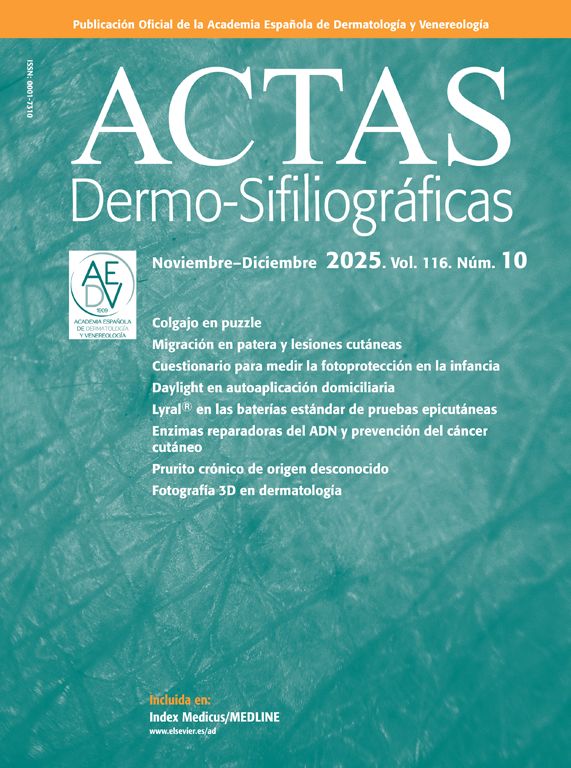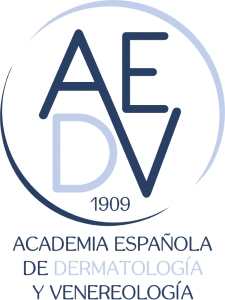Acne is the most common skin disease, affecting up to 85% of adolescents.1 Isotretinoin, a derivative of vitamin A, represents the therapy of choice in most cases of moderate-to-severe acne, due to its ability to act on the 4 main pathophysiological factors of acne: follicular hyperkeratinization, sebum hypersecretion, presence of Cutibacterium acnes, and inflammation.1 Nonetheless, the use of isotretinoin must be monitored due to its potential adverse effects, which include xerosis, cheilitis, headache, myalgia, hepatotoxicity, hypertriglyceridemia, and teratogenicity, among others.2,3
In 2008, Pelle et al. conducted an in vitro study, in which they evidenced the presence of histaminergic receptors in sebocytes, as well as a decrease in squalene levels associated with the use of antihistamines.4 Since then, a potential role for antihistamines in the treatment of acne has been hypothesized, due to their anti-inflammatory and antipruritic action, and their ability to reduce lipogenesis in sebocytes.1 Similarly, it has been proposed that the addition of antihistamines to isotretinoin therapy may have a synergistic therapeutic role and attenuate its adverse effect profile.1–3,5
Therefore, we aimed to assess the safety and efficacy profile of combined therapy with antihistamines and isotretinoin vs the use of isotretinoin as monotherapy, for moderate-to-severe acne.
We conducted an electronic search in Epistemonikos, the largest database of systematic reviews in health, which is maintained by screening multiple information sources, including MEDLINE, EMBASE, Cochrane, among others. Data from the primary studies were extracted from the systematic reviews and, then, reanalyzed. Subsequently, a meta-analysis and a Summary of Findings (SoF) table using the Grading of Recommendations, Assessment, Development and Evaluation (GRADE) approach were conducted.
We identified a total of 3 systematic reviews6–8 including 5 primary studies overall,1–3,5,9 4 of which were randomized trials (262 patients).1–3,5 Our analysis was based on the 4 randomized trials and is shown in Table 1.
Summary of findings (SoF) table.
| Antihistamines+isotretinoin vs isotretinoin monotherapy for moderate-to-severe acne | |
|---|---|
| Patients | Adolescents and adults with moderate-to-severe acne |
| Intervention | Antihistaminesa+isotretinoinb |
| Comparison | Monotherapy with isotretinoinb |
| Outcome | Absolute effects | Relative risk (95%CI) | Certainty of evidence (GRADE) | |
|---|---|---|---|---|
| Isotretinoin | Antihistamines+isotretinoin | |||
| Difference: patients per 1000 | ||||
| Decrease in lesion count by week 12 | Combination therapy vs isotretinoin monotherapy resulted in a greater decrease from baseline in non-inflammatory lesion count (44.8% vs 17.8% in 1 study1; 63.2% vs 44.5% in another trial3); in inflammatory lesion count (55.8% vs 22.9% in 1 study1; 75.9% vs 62.7% in another trial3); and in total lesion count (45.6% vs 18.7% in 1 study1; 66.07% vs 48.7% in another trial3), with statistical significance.Another study5 reported these outcomes as the count difference between both groups, also favorable to the combined therapy. | – | ⊕ ⊕ ⊕ ○eModerate | |
| Decrease in the Global Acne Grading System (GAGS) score by week 12c | Combination therapy showed a greater decrease in the GAGS score with respect to baseline vs monotherapy (63.1% vs 17.2% in 1 study2; 51.0 vs 38.5% in another trial3), in a statistically significant manner. | – | ⊕ ⊕ ⊕ ○eModerate | |
| Patient satisfactiond | One study1 showed that the mean patient satisfaction score was 3.4 (SD, 0.15) in the intervention group, and 2.75 (SD, 0.18) in the control group (statistically significant difference, P=0.008).Similarly, another trial3 found that in the intervention group, 42.1% of patients were “very satisfied” vs 22.8% from the control group. | – | ⊕ ⊕ ⊕ ○eModerate | |
| Paradoxical exacerbation | 298 per 1000 | 104 per 1000 | RR, 0.35 (0.16–0.75) | ⊕ ⊕ ⊕ ○eModerate |
| Difference: <194(Margin of error: from <250 to <74) | ||||
| Adverse effects | All studies reported the presence of adverse effects. One study1 found a lower rate of cheilitis (75% vs 90%) and pruritus (15 vs 45%) in the intervention group vs the control group. A lower rate of pruritus was also described by 2 other studies favorable to the intervention group (12.9% vs 71% in one trial2; and 18% vs 50% in the other3). No severe adverse events were reported. | – | ⊕ ⊕ ○ ○fLow | |
2 studies used desloratadine at a dose of 5mg/d, while another 2 studies used levocetirizine in doses of 5mg/d.
The GAGS divides the face, chest and back into 6 areas (forehead, each cheek, nose, chin and chest/back), and assigns a factor to each area based on the surface area and distribution/density of the pilosebaceous units. Each type of lesion is given a value depending on its severity (no lesions=0, comedones=1, papules=2, pustules=3 and nodules=4), and the score for each area (local score) is calculated using this formula: local score=factor x rating (0– 4). The overall score is the sum of all local scores. Scores from 1 to 18 are representative of mild acne; 19-30, moderate; 31–38, severe; and >39, very severe acne1–5.
In conclusion, the addition of antihistamines to isotretinoin therapy vs the use of isotretinoin as monotherapy likely decreases the counts of non-inflammatory lesions, inflammatory lesions and total lesions by week 12 (moderate certainty of evidence). On the other hand, the combination therapy likely decreases the Global Acne Grading System score by week 12; probably decreases the risk of paradoxical exacerbations; and likely increases patient satisfaction vs monotherapy with isotretinoin (moderate certainty of evidence). Finally, combined therapy may reduce the adverse effects derived from isotretinoin therapy, in particular cheilitis and pruritus (low certainty of evidence).
Informed consentNot applicable.
Data access statementThe authors declare their full availability for the delivery of data upon request.
FundingNone declared.
Conflicts of interestNone declared.
None declared.




